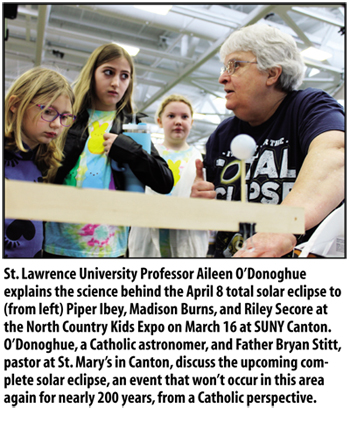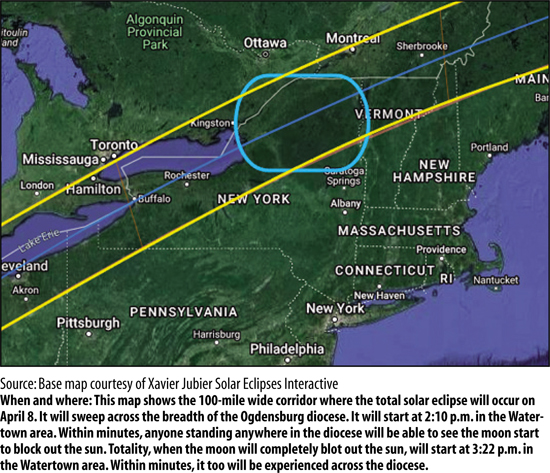March 27, 2024 By Keith Benman Catholics in the North Country will soon be able to experience a seldom-glimpsed aspect of God’s creation. “We will see stars in the middle of the day,” said Aileen O’Donoghue, an astronomer and professor at St. Lawrence University. “We will see planets and the corona of the sun … these 1-million-degree gases and particles that are flying off of the sun.” Birds will stop singing. The temperature will drop. It will be like dusk in the afternoon. No, it won’t be the End Times or the Apocalypse. It will be the total solar eclipse on April 8 – something that won’t be seen in the North Country for another 181 years. Of course, not just Catholics will see it, and excitement is growing for everyone. Both public and private viewing parties are planned all across the North Country. One will take place on top of a ski hill; another at a drive-in theater. There are estimates that hundreds of thousands of eclipse tourists could descend on the region. But some think Catholics and other people of faith may have a leg up when it comes to appreciating a once-in-a-lifetime event like a total solar eclipse. “When we see the awesome beauty of creation, we just know that there’s a creator behind it,” said Father Bryan Stitt, pastor at St. Mary’s Church in Canton. He’ll be thinking of that as he steps outside with his sister and her family that day, who are traveling 600 miles from Virginia to get a look at what promises to be a spectacular event. And for Catholics, there’s another reason to appreciate the day. April 8 will also be the feast of the Annunciation, when the angel Gabriel announced to Mary that the light of the world would be coming into the world. It just seems appropriate, Father Stitt said. “Catholics, through the ages, we’ve looked at Christ being like the sun and Mary being like the moon,” he said. And there’s another piece of advice at the top of her list: If you can’t resist pointing your phone that way at some point, then make sure you have an appropriate filter for the lens. Direct sunlight could damage it and render it useless. And the same goes for your camera. Of course, a cloudy day could put a damper on things. But it won’t be absolutely ruined. O’Donoghue was in Kansas for a total solar eclipse on a cloudy August 21, 2017. It got dark, birds and other animals got weird. In some places the clouds even miraculously parted so folks could get a glimpse. “It’s an event, even with clouds,” O’Donoghue said. O’Donoghue is a member of St. Mary’s Potsdam parish and a commissioned lay minister there. Her presentations deal with the science behind the eclipse. But she said her Catholic faith and belief in a divine being will also be on her mind April 8. “My faith and my science compliment each other,” O’Donoghue said. “My science teaches me about the wonders of this universe, which are incredible. And my faith helps me to see it as an act of love – the entire universe.”
|
||||



